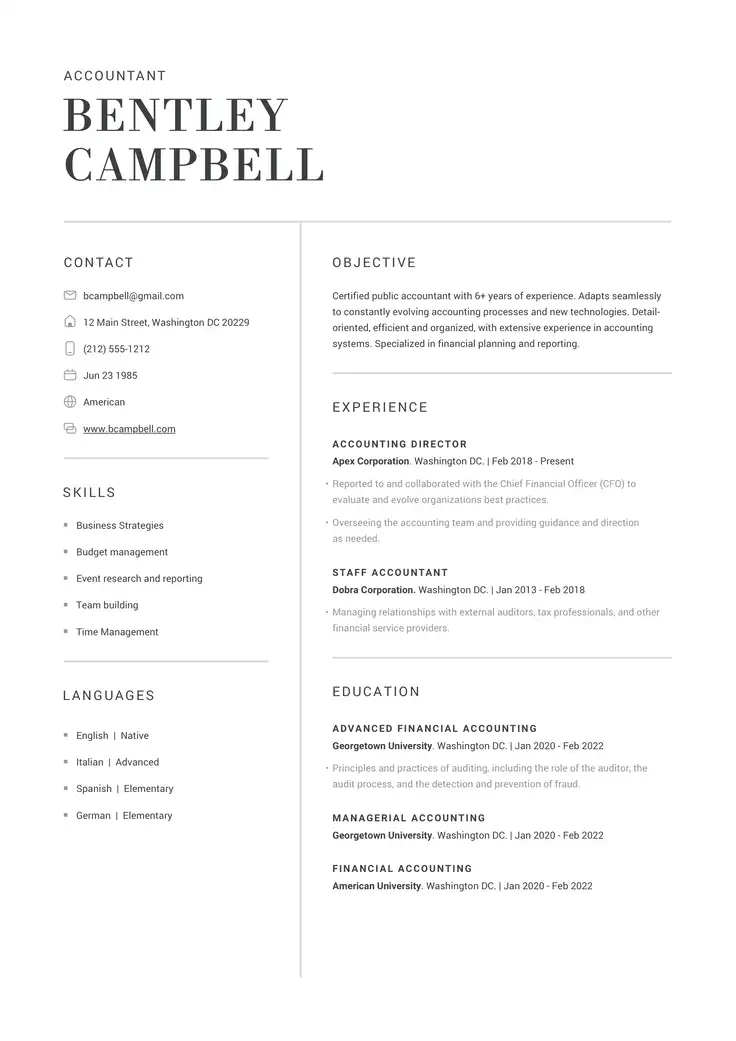- Why Should I Add Metrics to My Resume?
- Where Should KPIs Go on Your Resume?
- KPI 1: How You Stimulated Growth
- KPI 2: How Much Money or Time Did You Save The Company?
- KPI 3: Who Benefited From Your Work?
- KPI 4: How Many Tasks/Projects Did You Manage To Complete?
- How to Generate Meaningful KPIs if You Don’t Have Easy Access to Figures
Employers are always looking for measurable evidence that candidates have what it takes to succeed. Therefore, understanding the art of including KPIs on your resume turns into an invaluable element of securing a job offer, while leaving a profound impact on recruiters.
Key Performance Indicators (KPIs) are the most important criteria that can be used to assess your ability to do a job. However, different jobs will require you to emphasize different KPIs, which you’ll need to take into consideration when you create a resume.
To help you give your document the best shot at success, we’re going to show you how to include KPIs in your resume. Find out what kind of performance indicators employees will want to see on the page.
Why Should I Add Metrics to My Resume?
Knowing how to add metrics to your resume can be the game-changing factor that sets you apart from the competition. Numbers don’t lie, and in today’s competitive job market, presenting a quantifiable record of your achievements is more persuasive than vague descriptions.
Metrics provide concrete evidence of your capabilities, showing prospective employers not only what you’ve done, but how well you’ve done it.
With hiring managers and recruiters spending only seconds scanning each resume, a data-driven narrative helps them quickly and easily understand your value.
Here are some convincing reasons why you should include KPIs on your resume:
- Proof of performance: Metrics serve as tangible evidence of your achievements, demonstrating that you’ve met or exceeded professional goals.
- Attract attention: Numbers naturally draw the eye. Use them to emphasize your successes and keep the reader engaged.
- Showcase skills: Metrics can highlight your problem-solving abilities, teamwork, leadership skills, and other competencies that employers value by presenting tangible evidence of your achievements and capacity to drive results in your past roles.
- Speak the employer’s language: Businesses run on data. By speaking their language, you’ll demonstrate that you understand and can contribute to their objectives.
Whether it’s hitting sales targets, leading a team to success, or driving operational efficiencies, metrics make your success story more compelling and credible.
To add them correctly use our resume builder. It is full of expert tips and advice that will speed up the process and give you an edge over other candidates.
Where Should KPIs Go on Your Resume?
In the majority of cases, KPIs on resumes will appear in your work experience section. Using numbers and figures from your work from the past is highly effective in grabbing the attention of a hiring manager.
These will complement the skills and career history you state on the document by providing evidence and measurable criteria that you can do what you say you can. It’s all very well saying you’re the best salesperson ever, however, without the numbers backing it up the person reading your resume may remain skeptical.
KPIs are must-haves for your resume and by making them clear and easy to find, you’ll be able to make sure they stand out well to an employer reading your document.
Make sure to tailor these career achievements to the type of job you’re targeting to give your application the best shot at success.

KPI 1: How You Stimulated Growth
A major resume KPI that a hiring manager will want to see is how you fostered growth in a company. Businesses are always eager to seek new revenue streams and boost production or sales, therefore if you’ve got the numbers, flaunt them.
This can be reflected on the page in various ways. You can pinpoint the percentile growth you helped to realize, the new markets you helped your previous employers enter, or where you were able to increase output exponentially.
What Kind of Positions Use This KPI?
A hiring manager for any job where you generate products or make sales will be looking closely at the figures you can pull in or your output per hour. Highlight this KPI especially if you’re seeking work as a:
- Retail Manager
- Sales Manager
- Machine Operator
- Insurance Manager
- Factory Worker
- Trader
- Account Manager
- Press Operator
- Line Cook
- Store Manager
Resume Metric Example to Show Growth
Let’s look at a couple of examples to see this KPI in action.
Sales Manager
Achieved a 30% year-over-year revenue growth in the assigned territory, surpassing annual sales targets consistently.
This metric demonstrates the ability to drive sales growth and exceed targets. It quantifies the impact the sales manager had on the organization and provides evidence of their successful performance.
Line Cook
Implemented process improvements that reduced food wastage by 20%, resulting in significant cost savings for the restaurant.
In this example, their skill at implementing process improvements and effectively managing resources demonstrates their dedication to cost control and efficiency, which are crucial factors in the success of a kitchen operation.
By including this KPI, the line cook presents tangible evidence of their impact on reducing waste and contributing to the overall profitability of the restaurant.
Using the CAR Method
An alternative way to write these statements, if you wish to change the focus of the KPI, is to use the CAR method. This emphasizes the challenge first. You can formulate your impact statements by following this order:
- What was the Challenge that you faced?
- What specific Actions did you take?
- What were the measurable Results of those actions?
Let’s see an example:
Web Designer
Addressed an outdated website design challenge by revamping it with modern, responsive layouts, resulting in a 20% reduction in bounce rates and a 25% increase in online sales within six months.
KPI 2: How Much Money or Time Did You Save The Company?
Every company wants to maximize their efficiency and want to have people on their payroll who can help them do that. If you’ve helped streamline an enterprise’s finances, or you’ve found a new faster way to get work done, then a quick summary of some of these eye-catching figures needs to be on your resume.
Do this by marking down how much money you managed to save the company and how. Highlight where you brought these efficiencies and how you helped with their implementation. Also, note how you managed to reduce unnecessary expenses or tasks and how this allowed employees to focus more on more urgent jobs.
What Kind of Positions Use This KPI?
Job openings for positions where you are managing finances, projects, or efficiency within an organization will highly prize savings KPIs. This is the case with some of the following roles:
- Bookkeeper
- Financial Analyst
- Product Developer
- Data Entry Clerk
- Materials Engineer
- Software Tester
Resume Metric Example to Show Time or Money Saving
Look at how this works in real examples:
Bookkeeper
Implemented an automated expense tracking system, resulting in a time savings of 15 hours per week and increasing overall efficiency.
The bookkeeper’s experience in leveraging technology to streamline processes and save valuable time is displayed by this metric. It showcases their commitment to efficiency and productivity, both essential elements in the field of bookkeeping.
The applicant provides concrete details of their contribution to time-saving measures, which benefits their workflow and the efficiency of the company.
Software Tester
Identified and reported critical defects during testing phases, reducing post-production issues by 40% and saving $100,000 in potential rework costs.
In this situation, the KPI in focus is the “dodging of $100,000 in possible redo costs” done by the software tester. This number shows their talent in finding big issues during testing, stopping costly problems from popping up when the software is in use.
It also points out their strong commitment to keeping things at a high quality and the money value of their work.
Again, you could opt to emphasize the challenge you tackled. If so, you can phrase your impact statement using the CAR method we outlined previously, and it would look something like this example:
UX Designer
Initiated a comprehensive data analysis to identify underlying issues in response to declining user engagement (Challenge). Led a cross-functional team in redesigning the user interface (Actions), resulting in a significant profit boost of $500,000 (Results).
KPI 3: Who Benefited From Your Work?
Customers and other members of staff rely on your performance to achieve their own goals. Therefore, if you hold an essential role in a service position, or you’re the go-between for many departments or staff, this is a KPI you’ll want to draw attention to.
In doing so you should highlight how many people you were able to serve (this could be per hour, per day, or month), how many staff you managed, or how many departments you coordinated with. These will give a good indication of your ability to keep staff and clients happy and business booming.
What Kind of Positions Use This KPI?
People working in the service industry can benefit by using these figures to show they can attend to customers quickly and enhance communication between a broad range of departments. Be sure to list these performance indicators if you’re applying for one of these jobs:
- Barista
- Technical Support
- Call Center Representative
- Bank Teller
- Financial Advisor
- Taxi Driver
Resume Metric Example to Show Who Benefited From Your Work
Analyze these examples to gain a deeper understanding:
Call Center Representative
Handled an average of 80 customer calls per day, providing excellent service and resolving issues promptly to ensure customer satisfaction.
Here, the key measure we’re looking at is the “average of 80 customer calls each day”. This tells us how good the call center worker is at dealing with lots of customer chats, making sure customers are happy, and really helping the business to do well.
Financial advisor
Managed a team of 5 financial advisors, providing mentorship, training, and support to maximize their effectiveness in serving clients and driving business growth.
This scenario displays a metric reflecting who profited from their efforts in a strong way. Leading a group of 5 colleagues, they offered guidance, coaching, and assistance to enhance their efficiency in attending to customers and propelling the company’s expansion.
In this context, the beneficiaries are two-fold: both the team members who received guidance and professional development, and the organization which saw a growth in its business as a direct result of this effective leadership.
KPI 4: How Many Tasks/Projects Did You Manage To Complete?
Another key element Hiring Managers will want to see from candidates is the time it takes for them to turn around major projects. This not only tells the recruiter how fast you are at doing the job, but it also gives a good picture of your level of expertise.
This can be represented by the number of projects that you managed to complete in a year and the numberof meetings you organized per week or month amongst other things. Also, highlight times when you created essential plans and guidelines that helped the team succeed.
The most important thing to show the recruiter is that you were proactive and effective at doing the job.

What Kind of Positions Use This KPI?
If you’re working on big projects or your performance hinges on the completion of key tasks then it’s important to demonstrate that you can get things done. Candidates applying for any of the following jobs may want to consider marking this experience on their resume:
- Geologist
- .NET Developer
- Animator
- Software Engineer
- Actor
- Full Stack Developer
- App Developer
- Board Game Designer
- Creative Director
- Video Game Designer
Resume Metric Example to Show the Number of Tasks or Projects You Completed
Take a look at the examples below to see how it’s done:
Video game designer
Met all project deadlines, completing an average of 15 tasks per week, contributing to the timely delivery of high-quality games.
By including this KPI, the video game designer boosted their chances by showing how they effectively handle multiple projects simultaneously and their commitment to meeting deadlines, while managing their workload and meeting project milestones.
Geologist
Led and completed an average of 10 geological surveys, site assessments, and environmental impact assessments per month, showcasing exceptional project management skills and a consistent record of delivering results within deadlines.
The key figure to note is the “average of 10 geological tasks or jobs every month” tackled by the geologist. This demonstrates their capacity to balance multiple projects concurrently and achieve impressive results swiftly.
Their proven track record and versatility in managing a variety of tasks underscore their robust project management capabilities.
How to Generate Meaningful KPIs if You Don’t Have Easy Access to Figures
When faced with limited access to figures, generating meaningful Key Performance Indicators (KPIs) for your resume can still be accomplished. Don’t panic!
Consider the following strategies to create compelling KPIs that highlight your accomplishments:
- Percentage improvements:Showcase your ability to drive positive change by emphasizing how you increased customer satisfaction or reduced project completion time by a significant percentage.
- Comparative achievements: Demonstrate your stellar performance by stating that you outperformed sales targets or exceeded customer retention rates compared to the norm.
- Qualitative results: Shine a spotlight on the positive qualitative results of your work. Share compelling success stories, glowing testimonials, or remarkable feedback from clients or colleagues to convey the value you bring to the table.
- Scope and scale: Feature the size and scope of projects you managed, the number of team members under your leadership, the budget you handled, or the geographical reach of your initiatives. This information demonstrates your ability to handle significant challenges.
- Performance awards: If you’ve received any performance awards or accolades for your work, be sure to include them on your resume. These commendations validate your exceptional performance and reinforce your credibility.
- CAR Method: Use the CAR method if you wish to emphasize the challenges you overcame and answer three questions. What was the Challenge faced? What Actions did you take? What were the Results of those actions?
Remember, while specific numbers are ideal, the key is to provide as much context and evidence as possible to display your achievements. With these strategies, you can confidently create meaningful KPIs that impress employers, even when easy access to figures is limited.
Incorporating KPIs into your resume can sometimes be tricky, but with our resume builder, the process becomes straightforward. ResumeCoach’s online resume generation tools and templates can help you save time creating a not only aesthetically pleasing but also impactful resume.
Related Blog




